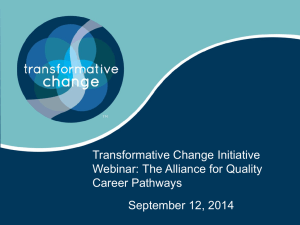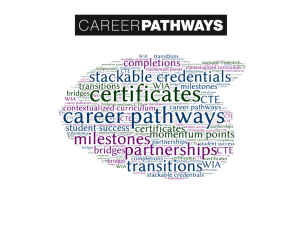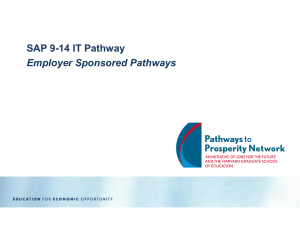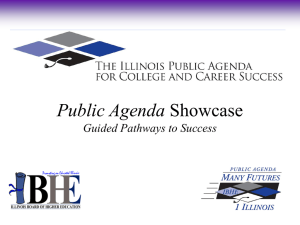Regional Spotlight, and Measuring Pathways Progress
advertisement
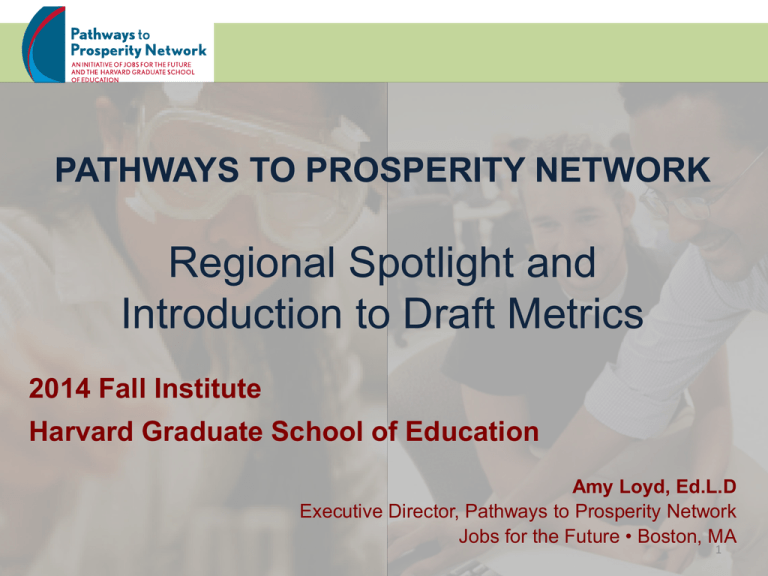
PATHWAYS TO PROSPERITY NETWORK Regional Spotlight and Introduction to Draft Metrics 2014 Fall Institute Harvard Graduate School of Education Amy Loyd, Ed.L.D Executive Director, Pathways to Prosperity Network Jobs for the Future • Boston, MA 1 WHO WE ARE, WHAT WE DO • Jobs for the Future is a national nonprofit that works with our partners (like you, and the Harvard Graduate School of Education) to design and drive the adoption of education and career pathways leading from college readiness to career advancement for those struggling to succeed in today’s economy. • The Pathways to Prosperity Network seeks to increase the number of young people who complete high school, attain a postsecondary credential with value in the labor market, and get launched on a career in a high-demand, high-wage occupation that can also provide the basis to pursue further education and career advancement. – While in high school, pathways provide at least 12 college credits through dual enrollment, and a continuum of real-world workbased learning to get a leg up on college and career THE PATHWAYS TO PROSPERITY NETWORK Eleven states with ~30 regions, rural to urban, serving as starting places for demonstrating success, with a focus on scaling grades 9-14 integrated academic and career pathways statewide. Not a new program or add-on reform, but a strategic alignment and bolstering of existing initiatives to improve education, workforce, and economic outcomes. OVERVIEW OF NETWORK POLICIES / PRACTICES Our challenges and emerging successes highlighted in recent report: http://www.jff.org/sites/default/files/publications/materials/Pathways-to-Prosperity-for-Americas-youth-080514.pdf REGIONAL APPROACH TO PATHWAYS DEVELOPING REGIONAL ECOSYSTEMS BUILDING PARTNERSHIPS ACROSS STAKEHOLDERS MANY STRENGTHS, AND MANY CHALLENGES 5 REGIONAL PATHWAYS STAKEHOLDERS Employers: Business & Industry Chambers of Commerce and Employer Organizations K-12 Schools Steering Committee and/or Intermediary Community Based Organizations Colleges & Universities Local Government 6 9-14 CHALLENGES • Creating shared vision and fostering collaboration across multiple districts and diverse stakeholders • Culture and systems change to integrate career-focused learning with academics in schools • Vertically aligning 9-14 pathways and programs of study between secondary and postsecondary • Need to develop relevant degree programs for pathways • Changing mindsets and public perception about career education and pathways • Increasing dual enrollment EMPLOYER ENGAGEMENT CHALLENGES • Business partnership development o Engaging new businesses o Overcoming history of mixed/unsuccessful partnerships o Sharing business partnerships broadly in region o Uncoordinated outreach efforts, too many contacts o Articulating ROI for businesses o Skepticism in working with high school students • Work-based learning at scale • Equitable access to and consistent quality of work-based learning • Creating a process for brokering work-based learning requests and employer connections OTHER CHALLENGES • Variability of commitment and capacity amongst partners • Implementation timeline challenges • Funding to support pathways • Data disconnect from disparate sources: K-12, postsecondary, workforce, business/industry • Building the plane while flying it! • Competing priorities and commitments impacting availability of partners catching people up on what they miss CALIFORNIA SPOTLIGHT: LONG BEACH IRVINE FOUNDATION LINKED LEARNING REGIONS CALIFORNIA CAREER PATHWAYS TRUST REGIONS 10 LONG BEACH, CALIFORNIA • Long Beach Unified School District is leading Linked Learning district • LBUSD partnering with Long Beach City College and California State University, Long Beach to develop built-for-purpose intermediary: the Long Beach Collaborative to Advance Learning for Life (LBCALL) – Nonprofit Workforce Development Team: industry sectors focus – Expanding Pathways Implementation and Innovation Council (EPIIC): steering committee – Search for executive director • Long Beach College Promise: fee-free semester at LBCC, guaranteed admission to CSULB, early outreach and supports • Two California Career Pathway Trust grants – $6M for health care and medical technology pathways – $15M for regional approach to advanced manufacturing • LBCC’s Promise Pathways, focused on educational partnerships and student outcomes GEORGIA SPOTLIGHT: CARROLL COUNTY BULLOCH COUNTY 12 CARROLL COUNTY, GEORGIA • Strong intermediary, Carroll Tomorrow/Carroll County Chamber of Commerce – Focused on business-education partnerships – Blue Ribbon Task Force • Committed community foundations provide support • Innovative business partnerships – Southwire / 12 for Life – Tanner Health Systems • Two school districts and two postsecondary institutions focused on developing pathways opportunities • Serving as a model for statewide replication/scaling ILLINOIS SPOTLIGHT: AURORA CHICAGO EAST ST. LOUIS PEORIA DECATUR 14 AURORA, ILLINOIS • Greater Aurora Regional Chamber of Commerce serves as regional intermediary – Catalyst Committee: top level administrators across stakeholders – Leadership Committee: top level leadership across stakeholders – Subcommittees for each pathway and Workplace Acumen • 4 districts committed to programs of study that integrate stackable, marketable credentials and work-based learning – Fall 2015 • Strong postsecondary partnerships 15 MASSACHUSETTS SPOTLIGHT: WEST SPRINGFIELD / HAMPDEN COUNTY BOSTON (SAP AND ROXMAPP INITIATIVES) BROCKTON MARLBOROUGH / METRO WEST 16 WEST SPRINGFIELD, MASSACHUSETTS • Strong 9-14 partnership in advanced manufacturing pathway development: West Springfield High School and Springfield Technical Community College • Regional Employment Board of Hampden County (WIB) serves as intermediary: leads convening, coordination, industry partnerships – Summer programming for students – Leading pathways expansion in health care and IT • Region uses MOU to define partnership commitment • Youth CareerConnect grant to deepen and expand advanced manufacturing pathway MISSOURI SPOTLIGHT: ST. LOUIS KANSAS CITY MID-MISSOURI 18 ST. LOUIS, MISSOURI • State Pathways to Prosperity Regional Director – Convenes Pathways District Coordinators • Innovation Campus grant for dual enrollment • Pathways for Teachers: summer externship program • St. Louis Region Executive Steering Committee – Four districts, two postsecondary partners, business and industry, workforce development, DESE • Education Plus Business Gateway: online platform to match district needs with business/industry • St. Louis School and Business Partnership: networking • Junior Achievement provides soft skill development and work-based learning experiences NEW YORK SPOTLIGHT: ALBANY / CAPITAL REGION NEW YORK CITY ROCHESTER P-TECH REGIONS ACROSS THE STATE 20 CAPITAL REGION, NEW YORK • Questar III BOCES serving as intermediary, connecting districts with postsecondary and industry • Numerous industry partners, including GE Health Care, Regeneron Pharmaceuticals, and SMT Group • Focus on capacity-building in urban, high-need schools • Troy Riverfront P-TECH as model for region: steering committee, ongoing communications across stakeholders, focus on biotechnology and advanced manufacturing • Vision for starting with end goal and reverse engineering pathways, coupled with strong middle school feeder programs OHIO CENTRAL OHIO 22 CENTRAL OHIO • $15M Straight A grant to jumpstart regional pathways development, responding to Central Ohio Compact • 16 partnering school districts—including the largest urban district in state, large suburban districts, and small rural districts • 6 pathways co-created and implemented across districts: business and logistics, advanced manufacturing and robotics, health careers (2), networking and digital technology, health information management technology • Columbus State Community College providing innovative online dual enrollment opportunities and serving as a core lead • Executive Committee and Steering Committee meet regularly to guide the work • Comprehensive communications support for pathways • Intermediary and logistical support from Educational Service Center of Central Ohio TENNESSEE SPOTLIGHT: UPPER CUMBERLAND SOUTHEAST SOUTHWEST OTHERS UNDER DEVELOPMENT 24 UPPER CUMBERLAND, TENNESSEE • 4 districts, pathways in health care and advanced manufacturing, offering work-based learning for first time, partnering with postsecondary in pathway development • Academic Career Coaches supported by TDE critical to implementation, student pathways planning support • Highlands Economic Partnership serving as the intermediary, had existing strong foundation in education and workforce development; convenes stakeholders regularly and leads Pathways as regional strategy • Tennessee Teacher Field Trips (tnteacherfieldtrips.org): externship program to learn more about industry, improve perception of sectors, integrate career-focused learning • Pathways School Counselor Advisory Summit: increasing capacity and ownership, feedback on materials, sharing implementation strategies ARIZONA REGIONS TO BE DETERMINED ASSET MAPPING UNDERWAY 26 DELAWARE STATEWIDE—THREE COUNTIES ASSET MAPPING UNDERWAY 27 MADISON (WISCONSIN) REGIONAL APPROACH TO PATHWAYS ASSET MAPPING LATER THIS MONTH 28 DRAFT PATHWAYS METRICS BY IMPLEMENTATION LEVER AND LEVEL SEEKING YOUR INPUT: EDITS AND ADDITIONS SEEKING VOLUNTEER ADVISORY GROUP TO FINALIZE 29 LEVER I: 9-14 PATHWAYS 30 LEVER II: CAREER INFORMATION AND ADVISING 31 LEVER III: EFFECTIVE INTERMEDIARIES 32 LEVER IV: EMPLOYER ENGAGEMENT 33 LEVER V: STATE LEADERSHIP AND POLICY 34 Amy Loyd | aloyd@ff.org Executive Director, Pathways to Prosperity Network TEL 617.728.4446 FAX 617.728.4857 info@jff.org 88 Broad Street, 8th Floor, Boston, MA 02110 122 C Street, NW, Suite 650, Washington, DC 20001 WWW.JFF.ORG 35
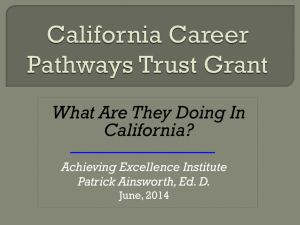
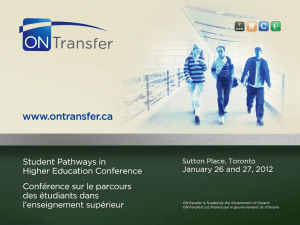

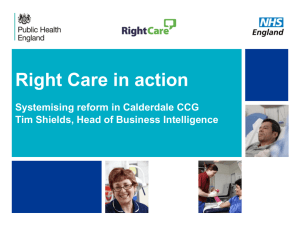

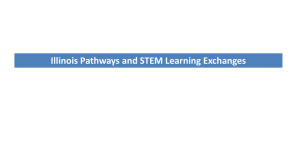
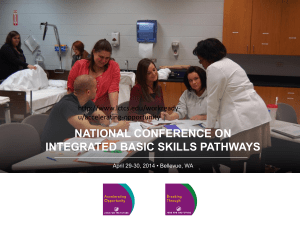
![locandina dottorandi [modalità compatibilità]](http://s2.studylib.net/store/data/005259821_1-9e349e4e3bf89f1cc48d1fe5ca196528-300x300.png)
